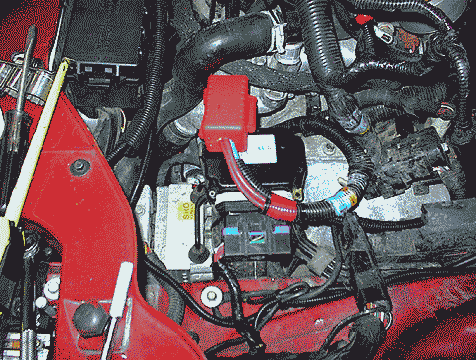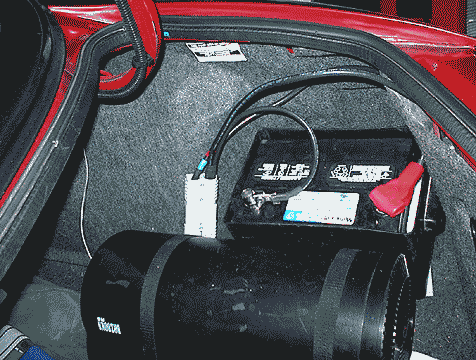

Thanks to Paul Nimz
I moved the battery to the right rear corner of the trunk in my '97 to give me more room under the hood for my air can. This is something I've been wanting to do since I bought my SHO over 2 years ago. It was relatively easy to do and not too expensive < $50.00.
Items needed :
The #2 AWG wire is rather stiff and can be bent to hold about any angle you want. I started by crimping one of the battery terminals on one end of the wire. A piece of 1/2" iron pipe cut in half length ways and about an inch long (do not use a fitting with threads on the inside), a square ended piece of 1/4" x 1/2" steel and a big hammer does the job as good as the $2000.00 hydraulic crimpers they use at work (I was amazed). Hint: use a Vice-Grips to hold the piece of steel when hitting with the hammer (don't ask).
I covered the wire with the 3/8" PVC loom so as to have double insulation of the wire. After removing the battery and mounting base run the cable back to the firewall and across to the passenger side. Then down to where the fuel lines run behind the left front wheel. I then followed the fuel lines back to the rear wheel and up into the trunk through the rubber drain grommet (enlarge the hole in the grommet to insure drainage). You may want to further insulate the cable at the fuel lines by using 1/2" loom over the 3/8" to triple insulate it here.
I put some Styrofoam in the rear well to bring the level up to that of the trunk floor so that the battery box will set level. When you pull back the lining here you will see a stud with a wire already attached. This is where you will attach your ground wire. Do not use the stud that is surrounded by the fiberglass panel as this is not a good ground. I used two #4 AWG THHN wires here in the trunk for the ground. (two #4 = one # 2)

In the front I used the bolts and holes where the battery box was attached to secure the original ground wires to. I then bolted the original positive cable and the new cable together and encased them in a plastic box for insulation and so I could get access if I would need to use jumper cables. I attached the Constant Control Relay Module (CCRM) to the battery box hold down bracket.

Tie everything down and enjoy the new found space under the hood and the effort you've done to help out the F/R weight distribution. As an added benefit, by moving the battery out of the engine compartment and away from the heat you do not need the "silver series" (a special patented high temperature alloy $$$) type of battery or as large of one for that matter. Fumes are inconsequential as long as your voltage regulator is not over charging the battery.
I would also wish for you to add that on my battery relocation article a fuse should be added to the cable at the battery for safety's sake. I added a 250 amp semiconductor slow blow fuse which is designed for a dead short protection.
Paul Nimz
'97 TR
Update - I just wanted to point something out. I was reading the link on the V8SHO site about the battery in the trunk and I remember reading some posts on the list about it recently. If you ever plan to run at any NHRA track, it is a rule that a battery cutoff switch be installed on the car if the battery is relocated. The switch must be accessible from the outside of the car, which means you usually have to mount it on the rear bumper or near there somewhere. Most people don't know this and will disappointed when they go to the track and don't make it through tech. Oh yeah, the car must cut off when the switch is turned off. It isn't as easy as just splicing the switch in the cable going from the battery to the solenoid. If the car is running and the switch is thrown, the car will still run from the alternator output. So the hot wire there will have to spliced into the same switch. I know from experience. If you don't ever want to drag race, then go ahead. But if you think you will someday, you will be disappointed when you don't meet the required rules of the NHRA, they are usually very strict about their rules. So keep that in mind, there's more to it than you may have thought.
Thanks to Keith Fromme
More Comments
T
hanks for the info. If one where to rig a couple of relays that when de-energized would disconnect from the battery, then ground the engine side and then open the grounded connection, I think it would do a good job of bringing everything to a halt and allowing a restart. - Paul NimzYou got the critical part right there: relays are
*de*-energized to turn off electrical power to the system. Fail safe. Doing it
the other way (energizing the relays to turn the system off) means that if the
wires to the relays are severed, you got a problem. - Bob Crispen
One disadvantage of doing this would be that the
computer would be drained whenever the switch was activated. You would want to
find a way of keeping the juice hot to the ECC under all conditions. I've
thought about using a two battery system with a small one hooked to the ECC and
the larger one hooked up as normally would be. The smaller battery could be a
deep discharge type which would last longer under the constant discharge state
that our SHO's are in during KOEO conditions.
Most relays have both Normally Closed and Normally Open contacts. One of these
with an old style Ford starter relay would be what is needed. Attach a piece of
light gauge lamp cord to a push button switch and let it hang out of the trunk
when racing.
Paul Nimz
'97 TR
'93 mtx
Hey Paul,
Don't take any offense at any of this, I am just spilling my guts. Just stuff to
think about.
Are those starter solenoids designed to be constantly engaged?
Two things I am thinking about are the coil heating up and the contacts
corroding shut, since they would hardly ever be open.
"Fail safe" isn't always as simple as , "make things stop if we
lose power here." There are some situations were the "fail safe"
is that a motor runs. In the SHO, I think that just a dedicated fused source for
the power to the relay would be appropriate, along with powering the relay to
allow the car to run.
As an extreme example, you probably would not want the car to stop if the
windshield wipers blew a fuse.
I would think that you might want to come up with a system that is only engaged
when you are racing.
I would also think that you would want to be careful about where you sent
unfused power.
Maybe an additional starter relay in the trunk near the battery would be a good
idea, so that you don't have that large unfused line to the starter constantly
hot. This would be totally separate from any power shut off switch, and I would
think it should be operational all the time. There's nothing like being in a
wreck, being trapped in the car, and having a pinched battery line start a fire.
I would also look into fusible links. I'm not sure if any of those are
appropriate for a starter circuit, though.
I would also see about getting a truly sealed battery. Either at the next swap,
or if yours is fairly new, you might be able to trade it with someone else and
get the Optima.
Doug